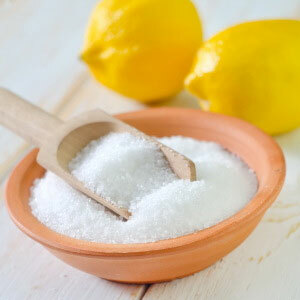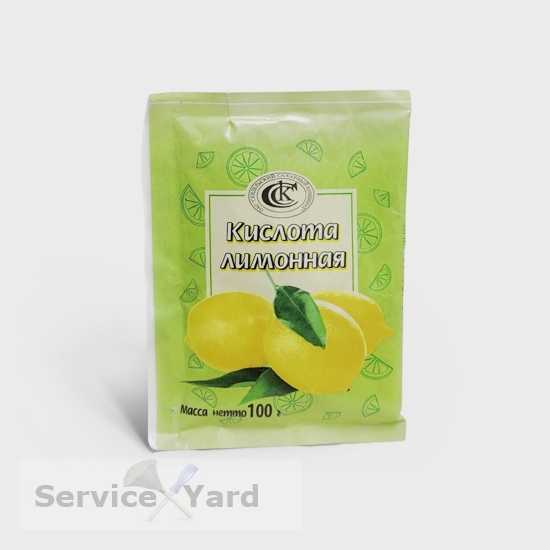
- Properties and benefits of
- Application of citric acid
- How do citric acid?
In the kitchen of any housewife, you can always find citric acid, which refers to organic acids and is a natural preservative. Citric acid is used for both domestic and industrial purposes. How do citric acid, as well as its properties, possible applications - all this you will learn from this article.
to content ↑Properties and use of
Citric acid or food additive E330 is a substance of the crystal structure. The additive E330 has a white color, is very soluble in water, ethyl alcohol and slightly soluble in diethyl ether.
The history of the emergence of
For the first time, the chemist-pharmacist from Sweden Karl Scheele in 1784 isolated acid from the juices of immature lemons. Molecular formula of citric acid C6H8O7, and its salts and esters are called citrates. By its action, the E330 additive is a synthetic or natural antioxidant.
Important! Additive E330 is widely distributed in nature and is found in berries, needles and stems of tobacco crops, as well as in all citrus fruits. A large content of antioxidant is characterized by immature fruit of lemon and Chinese magnolia vine.
Useful properties
 Food additive E330 is widely used in cooking, cosmetics and even in the oil and gas industry, thanks to its properties, namely:
Food additive E330 is widely used in cooking, cosmetics and even in the oil and gas industry, thanks to its properties, namely:
- Good solubility.
- Safety for the environment.
- Low toxicity.
- Good combination with other chemical elements.
- Has valuable healing properties:
- Is a participant in the metabolic processes in the body, which give ⅔ the necessary body energy.
- Helps to cleanse the body of harmful substances, slags and salts.
- Positively affects the digestive system: regulates acidity, enhances taste.
- Improves eyesight.
- Increases immunity.
- Burns carbohydrates.
- Discharges toxins through skin cells.
- Has valuable antitumour properties.
- Promotes an increase in the calcium content in the body.
- Normalizes the activity of psycho-neural systems
Important! All known food control organizations refer the above-mentioned antioxidant to a class of safe for health. On the territory of the CIS, the additive E330 is included in the list of permitted food additives.
to content ↑Application of citric acid
It is difficult to enumerate all the specific uses of this powder. But it is possible to identify areas and areas of use.
Food industry
Food additive E330, as well as its salts: potassium citrate, sodium citrate and calcium citrate, are used as a flavoring additive, as well as a preservative and acidity regulator.
Food additives E330-E333 are added to a wide variety of food products and are the most popular acidifiers. Citric acid not only gives the products a pleasant sourish taste, but also protects them from the damaging effects of heavy metals, that is, they act as an antioxidant. This property is particularly valuable in the production of beverages, bakery and confectionery products.
Important! This flavor additive not only makes the carbonated, non-carbonated alcoholic and nonalcoholic beverages fresh, but also a regulator of acidity.
Additive E330 is used as one of the components of baking powder in the manufacture of bakery and confectionery products. Combined with alkalis( for example, baking soda), the E330 additive reacts violently with the release of carbon dioxide. Thanks to this test, the puffiness and airiness are given.
The properties of the food additive make it possible to use it for the production of such products as:
- Ketchup.
- Mayonnaise.
- Jelly.
- Sauces.
- Jams. Canned food - meat, vegetable, fish.
- The gravy.
- Melted cheeses.
- Frozen food.
- Confectionery.
- Fruit and berry preserves.
- Cold teas.
- Toning beverages.
- Dried beverages.
- Effervescent vitamins.
- Beverages for sports.
- Carbonated and non-carbonated drinks.
- Alcoholic and non-alcoholic drinks.
Important! Citric acid is used as a preservative in order to increase the shelf life of products. Due to its properties, it is indispensable in everyday conditions when harvesting vegetables, fruits, berries, salads, etc. for the winter.
Cosmetics
 The E330 supplement is an integral part of many cosmetic products: lotions, elixirs, creams, hair fixators, shampoos, etc.
The E330 supplement is an integral part of many cosmetic products: lotions, elixirs, creams, hair fixators, shampoos, etc.
The valuable cosmetic properties of this antioxidant include:
- The ability to pull together the expanded pores of the facial skin.
- Whitening( depigmenting) properties.
- Strengthens nails.
Tips for use:
- To get rid of freckles, age spots, use a 2-3% solution of concentrated acid powder or juice of fresh lemon. Skin after applying this antioxidant will not only be clean, but will acquire a matte shade.
- To strengthen the nails, use this powder, dissolving together with lactic or malic acid.
Important! Do not use citric acid too often not to provoke softening of the nail.
Use and apply this nutritional supplement with caution, because:
- Dry powder, as well as too saturated its solution, can provoke skin irritation in people with sensitive skin.
- Inhalation of dry acid powder leads to irritation of the respiratory tract.
- In case of contact with the eyes, the antioxidant causes severe irritation.
- Excessive consumption of food additive E330 can damage tooth enamel.
- One-time use of a large amount of supplement can provoke cough and irritation of the gastric mucosa.
In everyday life
Citric acid is used at home not only in cooking, but also in other cases. For example:
- It is used for treatment of pain in the throat. Prepare a 30% solution of citric acid and rinse your throat every 30 minutes.
Important! In the absence of dry powder, use 2-3 slices of fresh lemon without skin. Slightly throwing back his head, slowly dissolve them so that the juice envelops the walls of the throat. It is recommended to repeat the procedure every hour until the painful symptoms are alleviated.
- Used to clean the kettle of scale. Proceed as follows:
- Pour a little water into the kettle above the plaque, not settling on the walls.
- Add 30 g of citric acid.
- Boil the solution.
- Drain the water with citric acid and the scale that has peeled off the walls.
- Boil the kettle with clear water.
Important! Carry out the descaling procedure as necessary.
- For cleaning the iron from scale:
- In a glass of water, dissolve 25 g of the product.
- Pour the prepared solution into the iron reservoir.
- Turn on the iron to the maximum temperature.
- Clean the appliance by pressing the steam button.
- After cleaning, perform the same procedure with clean water several times.
- Used for cleaning silver:
- In 1 liter of water, dissolve 20 g of citric acid.
- Pour the solution into the container.
- Place the silver items( chains, rings, coins, utensils and others) in the container.
- Boil the products in solution.
- After cleaning, rinse the silver with running water and dry.
- Used in preparing a nutritional solution for cut roses:
- In one liter of water, dissolve 40 g of sugar and 0.2 g of citric acid.
- Put roses in the solution.
How do citric acid?
Lemons and oranges were the main sources of the food additive E330, which was produced mainly in Italy. In the middle of the 19th century, the first plants for the production of crystalline citric acid began to operate in Italy. Later, similar plants began operating in California, Western India and the Hawaiian Islands.
For a long time valuable powder was obtained from the biomass of lemon or makhorka, however it was very unproductive, as in one lemon contains only 5-8% of acid, and after all in the world annually use the addition of E330 in the amount of 400 thousand tons. Therefore, more than 60years to produce such a product mold molds Aspergillus niger are used. Subsequently, a number of production strains for the biosynthesis of citric acid from sucrose were selected from this type of fungus. Fungi, feeding on sugary substances or sugar, secrete the desired substance in large quantities.
Important! Recently, experiments on the biosynthesis of food additive E330 with yeast from paraffins and lower alcohols have been successfully completed.
It is generally recognized that the production of citric acid by chemical methods is not economically viable, since:
- The cost of raw materials is much higher than the cost of molasses( sugars).
- Technology is multi-stage.
- Very toxic reagents are used.
- Low yield of the target product.
Therefore, despite the great progress, such a simple substance is mainly produced from sugar-containing raw materials with the help of microorganisms. This simplifies the technology, reduces the cost and increases the yield of acid. As raw materials in most countries, a by-product of sugar production from sugarcane or sugar beet is used.
We hope that you have learned a lot of new, interesting and important, reading this informative article about all the known, affordable food product. Use the information obtained, applying citric acid as necessary, but remember about safety measures.


